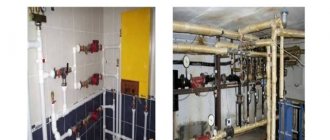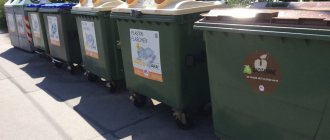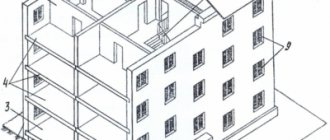Types of garbage containers
Containers are designed to collect and store garbage for a day or more. According to the established schedule, the containers are emptied and new ones are installed. Some types of containers are taken to the landfill along with waste. In other cases, emptying is done on site.
Containers are selected according to the volume of waste generated. Other factors that can affect the convenience of storage and transportation are also taken into account:
| Classification feature | Kinds |
| Location | In-ground, above ground |
| Design Features | Closed and open type, with and without handles, on transport wheels, etc. |
| Material of manufacture | Metal, plastic |
| Color | Grey, orange, blue, green, yellow |
| Purpose | For glass, waste paper, plastic, hazardous waste, etc. |
| Size | From 50-60 liters to 40 m3 or more |
Currently, the production of garbage containers is based on the standards set out in OST 22-1643-85.
The size of the garbage container is selected according to the purpose and type of waste that is planned to be stored in it. The greatest demand is:
- Metal tanks 1270x850x1170 mm;
- Plastic models 530x530x560 mm.
The sizes of containers from different manufacturers are not always the same, but they differ slightly. The containers are adjusted to the dimensions of garbage trucks and other equipment intended to service them.
Trash container sizes
The size of the solid waste container determines the capacity of the container. The sizes of containers are selected taking into account the purpose and type of waste.
Standard metal garbage tank with dimensions 1270 x 850 x 1170 mm with a volume of 0.75 cubic meters. With a volume of 0.8 cubic meters, the dimensions are 1270 x 850 x 1200 mm.
Plastic garbage can, holding 85 liters of garbage, dimensions 530 x 530 x 560 mm. Common 660 l containers – 1360 x 770 x 1180 mm.
It is important to consider that the dimensions of the waste container differ from one manufacturer to another. The dimensions of the boxes are taken into account when determining the approximate amount of waste materials, methods of transportation, resources required for disposal, and area occupied.
Recessed trash containers
This is the name for containers with a different type of installation. Unlike ground tanks, they are not placed on the site, but are buried in the ground, leaving about a third on the surface. Inside the container there is a bag, usually made of durable multi-layer polypropylene or woven material.
In terms of consumer qualities, recessed containers do not differ from ordinary ones. Such containers are useful from the point of view of high anti-vandal protection. They cannot be stolen, thereby causing damage to the regional operator, management company or private owner.
Garbage container designs
Depending on the purpose, design and volume, several types of containers are distinguished:
| Container type | Application |
| Special tank | Private sector. For collecting and storing small amounts of waste. They are compact, durable, have wheels for easy movement and a lid to block unpleasant odors. |
| Old style containers | Metal containers of conical or rectangular shape. Management companies are gradually removing such containers from use, but they are still found in small towns. Cons – small capacity, lack of wheels, heavy weight, ugly appearance |
| Eurocontainer for solid waste | Metal models with zinc coating. Resistant to low temperatures and mechanical damage. Close with a lid. Convenient for servicing with rear-loading garbage trucks |
| Model "Bell" | Large containers made of metal and fiberglass. Suitable for separate waste collection. Universal container for all types of waste, but more often used in construction. A manipulator is required for maintenance |
| Model "Boat" | For collecting waste in multi-storey buildings, including large items. Used during construction, installation and repair work. Served by special transport |
| Containers with hooks or for rope gripping | For collecting and storing bulky waste. Also used in the field of recycling. Installed on construction sites. Due to the large volume and weight, they are serviced only by special machines. |
Requirements for garbage containers
The waste collection and disposal process has standards, compliance with which is monitored by sanitary and epidemiological services and regulated by SanPiN rules. By law, garbage cans, plastic or metal, are subject to inspection according to a list of requirements:
- Serviceability. Garbage trucks lift containers off the ground to empty the contents into the loader, which is why the bins require special reinforcements.
- Tightness. Garbage bins are created to prevent waste from entering the environment.
- Size. There are standards for containers, and manufacturers must follow each one.
- Additional elements. Modern tanks must have gripping devices and transport wheels for comfortable lifting and moving the container, and a lid that prevents waste from spilling out. Depending on the material used in the manufacture, there are metal and plastic garbage containers.
Properly designed containers help contain the spread of unpleasant odors, their scattering, and prevent animals and insects from accessing them.
Metal containers
The production and selection of materials for steel containers is regulated by special GOST 12917-78 “Garbage bins and metal containers for household waste and food waste. General technical conditions". Rolled or edged sheet steel is suitable for the manufacture of tanks. At the last stage, in order to protect from the atmosphere, the containers are coated with a layer of zinc. As a result, the service life of metal containers increases and reaches 20 years.
What is the volume of garbage containers?
How much garbage will fit in the container is reflected by the volume indicator. Capacity affects the weight of the container when fully loaded, which is necessary to know for safe loading, transportation and unloading.
Volume of mobile plastic containers
We are talking about containers for waste collection in the private sector. These are small containers that, in addition to their low weight, have a minimum capacity of no more than 60 liters. The container has a lid and transport wheels.
Designed in such a way as to simplify the loading and movement of waste, as well as to prevent the scattering of waste by animals, and to block the spread of unpleasant odors. The only negative is the quick filling and the need for frequent unloading.
Eurocontainers
A durable, maneuverable option suitable for servicing apartment buildings and office centers.
They have a presentable appearance.
Capacity ranges from 1.1 – 1.3 m3.
Suitable for all types of municipal waste - organic and inorganic.
"Bell"
An ideal choice for separate waste collection. This is a container model for underground installation. Recessed tanks produce volumes up to 5 m3.
More suitable for plastic waste and waste for recycling.
To unload and transport buried tanks, equipment with special grippers is used. It is this moment that causes inconvenience for service companies.
For this reason, they are not widely used in Russia.
"Boats"
Available in a wide range of shapes and sizes. They can be small and hold no more than 1.3-1.5 m3 of waste, or huge to accommodate 40 or more cubic meters of waste. “Boats” in the shape of a trapezoid are in great demand - these are installed on the territory of industrial enterprises and construction sites.
Suitable for almost any type of waste goods, including broken glass, large items, bulk materials, etc. The largest forty-cubic containers are suitable for industrial enterprises. They contain metal structures, large concrete fragments and other large items with heavy weight.
The most common and in demand are side-loading or top-loading containers with a volume of 8, 20, 27 m3. These are purchased, and more often rented, by construction companies and industries.
Classification of waste containers
Containers for solid waste vary in volume, color, material, purpose and design. Garbage containers come in different types - for municipal solid waste, food waste, hazardous waste, plastic and paper.
Reference. The largest landfill is located in the United States. It covers an area the size of 1,700 football fields.
By container volume
The sizes of waste disposal containers are standard. In the private sector, small containers with a volume of 50-350 liters are installed. They are convenient, compact, but require constant emptying.
Small settlements are still equipped with old-style tanks from 0.5 to 0.6 m3. They are gradually being replaced with standard ones. In large cities, containers are installed in European sizes. They meet the requirements - comfortable, attractive, voluminous.
The volume of containers for separate waste collection is from 2.6 to 4.9 m3. For bulky waste, large-volume garbage containers from 25 to 45 cubic meters are installed.
According to the material of manufacture
Tanks for solid household waste are made of plastic or metal. It is rare to find galvanized containers. The material used for manufacturing is thicker than for other purposes. Metal trash cans weigh more than plastic ones.
In the production of plastic containers, primary polymer is used for strength. They do not absorb odors, are easy to wash, and can withstand temperatures from -35 to +50˚C.
By coating color
It is easy to notice that the trash cans are painted in different colors - red, black, green, yellow. The color depends on the purpose of the container. Anti-corrosion paint is applied to metal containers to protect them from atmospheric influences.
By purpose
In Russia, separate waste collection began to be practiced relatively recently. This makes it easier to send waste for recycling. Green containers are intended for glass. Paper waste is collected in blue bins, food scraps are placed in black bins.
To remove hazardous waste, such as batteries, accumulators, broken thermometers, there must be brown containers; plastic waste is collected in orange containers.
By type of design
The containers are made in the form of rectangles with a reinforced bottom. Most trash cans are designed on wheels for ease of movement. The lids are made hinged or removable. They have holes for dumping waste packages. For bulky waste, large metal trash cans are installed.
Interesting! Sweden only recycles about 4% of its waste. The rest of the garbage is recycled. Revenues from processing replenish the country's treasury.
Purpose of containers for different spheres of life
| Use case | Drive type |
| For indoor container sites (this also includes school areas, sites at offices, private homes, children's and medical institutions) | Tanks with a capacity of up to 1.3 m3 |
| House with garbage chute | Storage tanks with a capacity of no more than 1 m3 |
| Housing and communal services containers | Storage tanks with a volume of 8 m3. Suitable for places where the tank fills quickly, but it is not possible to install larger containers |
| Large residential neighborhoods, large office centers, retail marketplaces, construction projects | Garbage receptacles with a volume of 8 m3 and a carrying capacity of at least 5 tons. |
| Sites where construction of large facilities is underway | Containers of 20 m3 for a weight of 10-12 tons (loading is carried out using equipment with a microlift system). Tanks with a capacity of 27 m3 are used for collecting large-sized structures, as they have high sides. Tanks of 32 or more cubic meters are rarely ordered, since they require a lot of space, are expensive, and require the use of heavy equipment for loading. |
Container for solid waste
Garbage containers (tanks) for MSW (solid household waste) are metal products designed for collecting small and medium-sized waste. The garbage can allows you to dispose of up to 400 kg of household, industrial and construction waste.
| Dimensions (H x W x D ), mm | volume, m3 |
| 960 x 800 x 600 | 0.5 |
| 1000 x 900 x 700 | 0.63 |
| 1100 x 900 x 700 | 0,75 |
| 1250 x 950 x 800 | 1 |
Design
The design of garbage containers is as unified as possible.
- Containers differ in the volume of collected waste - 0.5, 0.63, 0.75 and 1 m3.
- Containers differ in the thickness of the metal used - 2 and 3 mm.
- To grip the container with a hooking device, the upper edges around the perimeter are reinforced with a metal corner.
- In places exposed to possible mechanical loads, the structure is reinforced with a metal corner.
- Metal legs are welded to the bottom of the container from the corner.
- At the junction of the body, the containers are welded with a continuous seam.
- The paintwork of metal elements is GF-021 primer; painting in any color is possible, as well as applying company logos. Containers are covered with paint completely outside and inside - to one third of the height.
Packaging and transportation
For compact storage and transportation, the products are inserted into each other. This packaging method can only be limited by the length of the car body. Therefore, tanks can be transported very economically. You can also stack containers on two floors (on top of each other), but the paint layer may be damaged.
In case of delivery of containers with a lid, in order not to damage the lids during transportation, the lids are unfastened and placed separately on the pallet.
Containers are supplied without packaging; if desired, they can be packed with cardboard and stretch film.
Supporting documentation
Product passport, delivery agreement, work completion certificate, certificate of conformity, goods and delivery notes, invoices and invoice for payment.
Warranty
The warranty period is 1 year, the estimated service life is 20 years.
Additionally, it is possible to equip with protective metal covers of various sizes, industrial wheels of various diameters, reinforcing structural metal elements, etc.
Useful tips
- You should know that when choosing small-volume garbage cans, you should not strive to increase the thickness of the metal structure for its higher strength. For a container with a volume of 0.5 m3, a metal thickness of 1.5 mm will be sufficient; this will allow it to lift 200 kg of garbage waste (along with its own weight), since it simply will not fit more.
- In some cases, when using a container with a volume of more than 0.8 m3, difficulties may also arise when loading them due to the large weight of the container with garbage, since not every special vehicle can lift such a large weight.
- An interesting fact is that containers with the same metal thickness with a small volume are much stronger than containers with a large volume. This is due to the fact that containers with a large volume have a much larger wall area without reinforcements, so when the structure is loaded they are more susceptible to deformation.
- When ordering garbage containers, you must be guided by their operating conditions. For example, for one entrance of 40 apartments in a residential apartment building, one garbage container with a volume of 0.75 m3 is sufficient.
It is worth noting that often the buyer saves and purchases plastic Euro containers. The advantage of plastic is that it is much lighter than metal, so it is believed that a plastic Euro container will be able to dispose of more waste by weight than a metal one. But, unfortunately, this is only the only advantage.
Advantages of a metal container over a plastic one
- Plastic becomes brittle at very low temperatures. This is especially important during cold winters.
- Plastic is flammable, so there is a risk of fire, for example from a carelessly thrown cigarette butt. Fire occurs very often. In the city of Chelyabinsk alone, according to official reports, up to 100 plastic containers are burned in a month!!!
- Plastic has lower strength compared to metal.
- A metal container is much cheaper than a plastic container.
You can buy metal garbage containers (tanks) by placing an order on our website or contacting us by phone or email.
Also, in addition to containers, you can order fences for garbage containers from us.
Requirements for containers
Garbage containers are produced according to the rules and technical requirements:
- A strength belt must be included in the design of any waste collection container. The element prevents deformation of the container and also serves as a holding part during mechanical transportation;
- Metal containers with dimensions of no more than 860 x 1200 x 1130 millimeters are suitable for installation in waste bins;
- Tightness is the main requirement for all types of waste storage facilities, especially at a height of at least 1/3 from the bottom;
- Containers must have devices that facilitate convenient unloading of waste. It is advisable to use containers on transport wheels to move the storage unit around the site. Lids help keep the contents inside the container during strong winds, prevent food waste from being carried away by animals, partially block the spread of unpleasant odors, and create an aesthetically pleasing appearance on the site.
Painting is carried out in accordance with GOST. In containers with a lid, the gap when closing cannot exceed 4 mm. Garbage containers are adjusted to the requirements of GOST 15150-69 according to the climatic modification parameter UHL1.
Basic requirements for solid waste containers
To ensure that waste does not have a negative impact on the environment and human health, containers must meet certain requirements:
- the bottom and side walls must be sealed;
- the upper edge is reinforced with metal corners;
- reliable;
- stable;
- have grips;
- standard dimensions of a garbage container;
- sealed lid;
- presence of wheels. Solid household waste decomposes quickly. Sealing the container will help prevent leakage and spillage of debris. The upper reinforced edge will protect against deformation when gripping and loading. The lid will prevent dangerous fumes from polluting the air and spreading waste by the wind.
Responsibility for maintaining garbage containers
The local administration is responsible for landscaping sites and maintaining garbage containers. Federal Law No. 458-FZ (Article 23, part states that the removal of MSW on the territory of the Russian Federation is a paid service. The organization of waste collection and removal is carried out by a specially appointed regional operator. The company develops a removal schedule and monitors order at container sites Sometimes the authority to install containers is transferred to management companies. More information about the procedure for managing solid waste can be found in the Decree of the Government of the Russian Federation No. 1156 .
states that the removal of MSW on the territory of the Russian Federation is a paid service. The organization of waste collection and removal is carried out by a specially appointed regional operator. The company develops a removal schedule and monitors order at container sites Sometimes the authority to install containers is transferred to management companies. More information about the procedure for managing solid waste can be found in the Decree of the Government of the Russian Federation No. 1156 .
For sanitary cleaning of territories, special sites are set up and containers for solid waste are installed in local areas, near trade enterprises, preschools, educational and administrative institutions, sports centers, at railway and bus stations, at airports, etc.
Types of containers for collection and removal of household waste
Special containers for solid waste ensure the collection and removal of household waste to the disposal site. They come in various types. Their distinctive characteristics include:
- material: high-strength plastic or durable steel sheets of different thicknesses;
- container design: monolithic or prefabricated, as well as closed or open type;
- form;
- weight, overall dimensions and carrying capacity of the container;
- the presence of two or four rollers for easier movement of solid waste containers;
- color shades;
- price.
The composition and quantity of waste, as well as the location of the site for installing containers, determine the optimal choice of designs.
Features of solid waste containers for waste collection and removal
Containers for collection and removal of solid household waste differ in some design features. To avoid deformation, damage and loss of tightness, containers are reinforced with special strong strapping along the upper edge of the side and additional stiffening ribs. To facilitate their unloading, handles or grips are attached to some types of devices, and the presence of drains allows you to increase their service life. Legs or wheels on containers protect the bottom from wear. Containers with lids are distinguished by the presence of loops for padlocks and reliable protection from the harmful effects of precipitation.
Advantages of structures for collection and removal of household waste
Containers for collecting and removing waste are necessary for the implementation of traditional sanitary cleaning schemes. All types of containers for solid waste have many advantages:
- high quality;
- compliance with the requirements of established sanitary standards and rules;
- strength, reliability and long service life;
- resistance to ultraviolet radiation, precipitation and temperature changes;
- ease of operation, maintenance and transportation;
- variety of types and colors;
- high stability;
- Possibility of manufacturing to special sizes;
- affordable prices.
Proper operation and optimal selection of waste containers can effectively solve the problem of waste collection and disposal in any city and town.
How many containers are needed - calculation example
MSW accumulation rates are established for different types of objects. The parameters are obtained by performing calculations using established formulas.
Values for apartment buildings, offices, production facilities, and administrative institutions may differ. But it is this indicator that is taken as the basis when calculating the number of garbage containers. In particular, the result depends on the following data:
- Annual volume of solid waste (A);
- Frequency of garbage collection per day (B);
- Container volume (C).
Types of containers for separate collection
Garbage containers for separate collection are divided depending on the type of waste they are intended for. The following color values are common:
- glass containers (bottles, jars) are placed in green tanks;
- blue containers are needed for paper (magazines, newspapers);
- cardboard (shoe boxes, household appliances) is thrown into the yellow ones;
- plastic is placed in orange (bottles, food containers);
- organic waste (leftover food) is placed in black containers;
- brown ones are needed for hazardous waste (batteries, accumulators);
- Non-recyclable waste is thrown into red bins.
These values may vary depending on local standards.








